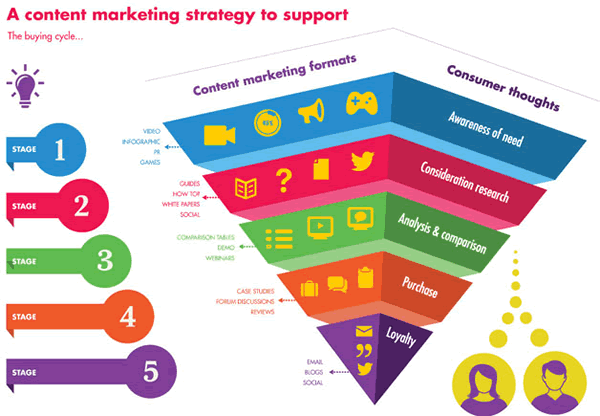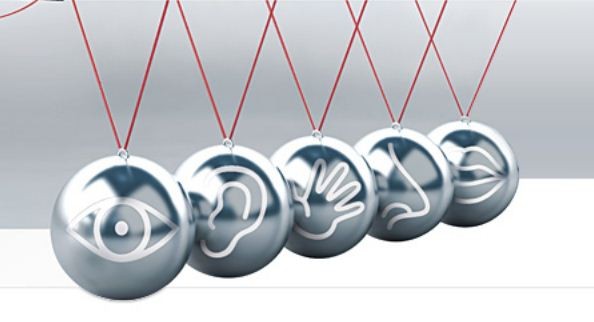 |
| Source: fracklemedia.com |
- Different types of content
- How to stand out with relevant content? (Brand and product related)
- How to engage the customer in the content creation process to increase customer involvement?
1. Different types of content
First of all I would like to present a definition of content marketing: Content marketing's purpose is to attract and retain customers by consistently creating and curating relevant and valuable content with the intention of changing or enhancing consumer behaviour. It is an ongoing process that is best integrated in your overall marketing strategy and it focuses on owning media, not renting it. (Content Marketing Institute in Hillary 2015, 28)
The graphic compares content marketing to traditional publicity. Content marketing gives valuable information, thereby creating customer's loyalty to the brand. It can create reciprocity among clients who ultimately buy out of gratitude. Companies should create viral content that links to the website and through the use of various multimedia formats, a different public can be attracted. Forms of valuable content are blogs, pod casts, downloadable guides and infographics.
 |
| Cuong 2014 |
 |
| Source: i-scoop 2015 |
The infographic by i-scoop (2015) describes the different content marketing formats and connected consumer thoughts in the different stages of the sales funnel.
In stage 1 of the buying cycle, videos, infographics and games create an awareness of the need. Guides, social media, white papers and how-to-instructions lead to a consideration research in stage 2.Demos and webinars as content marketing formats result in the analysis and comparison stage of the consumer. The initial purchase can be ascribed to case studies, reviews and forum discussions. Consumer loyalty is reached by the use of emails, blogs and social media.
Deshpande (2015) has created a huge graphic comprising all the tools that can be used to generate a content marketing strategy. There are tools to source the contents, to produce and compose, to organise content marketing and to distribute the campaigns via different channels and also to measure and analyse the marketing campaign.
Different authors distinguish between long form and short form content (e.g. Dittert 2015):
- Long form content: Long-form content is described as content that is typically 2,000 words in length or thereabouts and makes for a compelling, insightful read. Examples of long-form content include whitepapers, e-books, guides, resources, videos, and webinars. There are a number of reasons to use long form content. First and foremost, omnipotent search engine Google will rank a long form piece of content over a short form one. In-depth blog posts, informative white papers, educational webinars, and similar types of content are the perfect platform to demonstrate expertise on a specific topic and/or industry. Additionally, your company’s long-form content provides valuable information to a highly-invested audience that wants to learn more about your area of expertise.
- Short form content: Blog posts under 1,000 words, social media content, infographics, and articles are perfect examples of short form content. Online users have a tendency to scan through content, rather than reading every last word. Using concise verbiage, a brand can convey a strong message to their audience quickly and effectively. Also, short form content is more mobile-friendly than its long form counterpart, allowing it to reach more people.
- Cuong 2014. The principles of content marketing. URL: http://itsonlinemarketing.com/principles-content-marketing/ Accessed: 20.11.2015.
- Deshpande 2015. Content Marketing Tools: The Ultimate List. URL: http://www.curata.com/blog/wp-content/uploads/2015/07/Tools-Update-v1.png Accessed: 20.11.2015.
- Dittert 2015.Long Form vs Short Form Content: Which to Use When & Why. https://www.v9seo.com/blog/2015/08/18/long-form-vs-short-form-content-which-to-use-when-why/ Accessed: 20.11.2015.
- Hillary 2015.Customer Engagement Officer (CEO): Content Marketing and the Realities of Executive Blogging. Carnaby Books. Sao Paolo.
- i-scoop 2015. Content marketing strategy: content formats in the changing buyer journey. URL: http://www.i-scoop.eu/content-marketing/defining-content-marketing-strategy/content-marketing-strategy-content-formats-changing-buyer-journey/ Accessed: 20.11.2015.
Again, I would like to start with a quote that defines the essentials of content marketing: Basically, content marketing is the art of communicating with your customers and prospects without selling. It is non-interruption marketing (compare also the infographic traditional publicity vs content marketing). Instead of pitching your product or services, you are delivering information that makes your buyer more intelligent. The essence of this content marketing strategy is that we, as businesses, delivery consistent, ongoing valuable information to buyers, they ultimately reward us with their business and loyalty. (Hill 2015, 29)
According to Catherine Toole (2015), content that is too product- or brand-focused does not travel well digitally, whereas content that stands on its own merits as entertainment, storytelling, education will be shared and passed along.
Furthermore, she also name 5 principles of marketable content:
- Searchable: Search engines reward sites that deliver regularly refreshed content of a high editorial quality. Whether it’s for education or entertainment, your content needs to deliver both quality and impact.
- Shareable: As well as the benefits of gaining peer approval for your content, the social shares it attracts will also boost its search rankings.
- Supportive: You can project yourself as an authoritative brand that’s generous with its expertise by anticipating users’ questions and telling them things they didn’t know. But first, you have to make sure you understand your users’ information needs.
- Specialist: Your content must come from within your information niche – the intersection between your domain expertise and your users’ content needs and interests.
- Sustainable: You need a publishing process in place that allows you to generate ideas, populate an editorial calendar, and create relevant, effective content on a sustainable basis.
Pulizzi (2013) describes six principles of epic content marketing:
- Epic content fills a need: The content should address some unfulfilled/unmet need or answer a question the customers have. In some cases it may fulfil an emotional need (Coca Cola/RedBull as examples of storytelling effort)
- Consistent communication: In terms of quality and delivery. According to Pulizzi, epic content reliably delivers on the promises your brand makes. Whether you are asking your audience to subscribe to a monthly magazine or daily email newsletter, you must ensure that they receive what they signed up for and that it always arrives on time and as expected. This is where so many companies fall down.
- Requirement of a unique and human voice: A company should find its voice, if the company's voice is all about humour, it should be shared.
- Expressing a point of view: Companies should not be afraid to take positions and to take sides on matters in the company's field of expertise. Pulizzi names the examples of
Chipotle’s runaway viral hit The Scarecrow, which clearly has a point of view — that locally sourced and responsibly produced food is superior to how most food is processed today. - Devoid of sales speak: At Content Marketing Institute, when we create a piece of content that is about us vs. an educational post, it only garners 25 percent of the average page views and social shares our content normally drives. The more you talk about yourself, the less people will share and spread your story. It’s that simple.
- It is recognised as the best: Though you might not be able to achieve this at the very beginning, the ultimate goal for your content is to be considered the best in its class. I know it may sound overly simplified, but if you expect your customers to spend time with your content, you must deliver amazing value to them, and nothing less.
Content Marketing 2014 One example named is Coke: You have to admire the way Coke keeps pushing for creative content, even as one of the world’s most valuable and established global brands. Their “Share A Coke” campaign was a standout campaign of 2014, and it’s still going strong this year. Coke’s digital content keeps interactive features at the forefront.
Sources:
- Pulizzi 2013. 6 principles of epic content marketing. URL http://contentmarketinginstitute.com/2013/09/principles-epic-content-marketing/ Accessed: 20.11.2015.
- Toole C. 2015. Brand as publishers: Inside the content marketing trend. URL: http://curve.gettyimages.com/article/brands-as-publishers-inside-the-content-marketing-trend Accessed: 20.11.2015.
3. How to engage the customer in the content creation process to increase customer involvement?
The ultimate goal of a content marketing campaign is to trigger peoples' actions. Patel (2015) describes 5 things that should be added to blog-posts to increase engagement. First of all he starts by a definition of content engagement, which is real people responding in measurable ways to your content. According to him, engagement starts with objectives, so companies/authors should realise their goals of content marketing which can be as follows:
- Increase leads
- Increase page views (Note: For many sites, the goal is simply to increase traffic separate from any other level of site activity.)
- Boost brand awareness
- Encourage audience interactions such as:
- Comments
- Social sharing
- Quizzes and personality identifiers
- Comments – People share their thoughts, ask questions, or criticise your blog post.
- Social sharing – Users share the article on their personal social networks.
- Dwell time – How long do users stay on the page? This metric available in Google Analytics tells you if people are spending time on the page.
- Reading – RavenTools says “the best way to measure reader engagement is to track user scrolling.” Tools such as Crazy Egg allow you to view scroll maps (where, how much, and how far people scrolled) and heat maps (where people click).
- Links – The quantity and velocity of inbound links tell who considers your content to be important. More links equal a higher trust, better SEO, and more readers.
- Conversions – Whatever your conversion action, it is one of the most meaningful engagement metrics. Many blogs use email sign-ups as the primary conversion action.
- An obvious point: Article/blog should be clear about what to say. Therefore it should have an obvious point, which is recommended to be stated in the header already.
Your opening paragraph or two should convey your basic idea. Don’t leave people wondering, “What the heck is she going to say?” Put forth your main idea, then develop it. The point should be repeated in the conclusion again. - Structure: According to Patel, the structure includes both logical and visual structure.
- Logical structure — Make it coherent.
- Visual structure — Make it easy to read.
- Headings
- Short paragraphs (no longer than seven lines)
- Bullet points
- Numbered lists
- Conclusion: How does your article end? If it concludes with a whimper, then your readers will whimper away without engaging. If it ends in confusion, then your readers feel the same. If it ends abruptly, your readers won’t know what to do next. If we follow Patel instructions, a great conclusion consists of the following elements: It is labelled as a conclusion, short, it sums up concisely and encourages action.
- A question: If possible and suitable, articles should end with a question. It forces people to think and apply the principles that were formerly explained. Asking and answering questions is one of the most effective techniques for teaching critical thinking and building knowledge. A simple question in closing helps to produce this response.
- A bit of controversy
Since it is always relevant to bear in mind trends and developments, the trends of content marketing for the next years are examined as well. The following infographic describes the past, present and future trends in content marketing.
 |
| Source: Business2community 2015 |
- Business2community 2015. Do you need a rainbow in content marketing? http://www.business2community.com/content-marketing/do-you-need-a-rainbow-in-content-marketing-01268749 Accessed: 20.11.2015.
- Patel 2015. 5 Engagement-Driven Elements You Should Add to Every Blog Post. URL: http://contentmarketinginstitute.com/2015/03/engagement-elements-blog/ Accessed: 20.11.2015.



